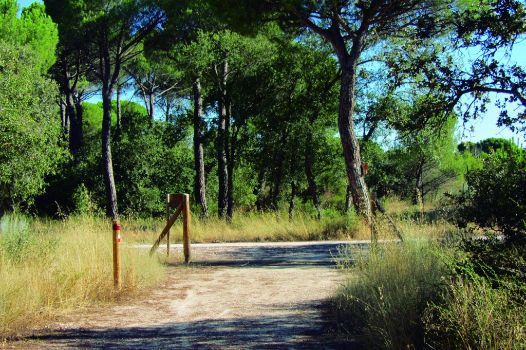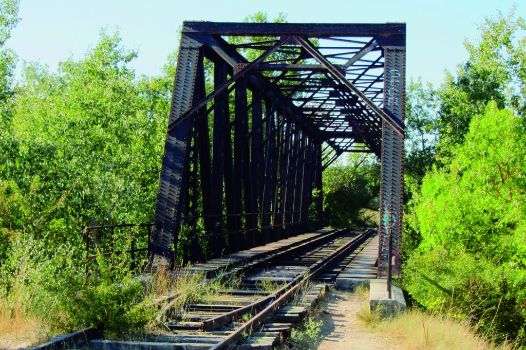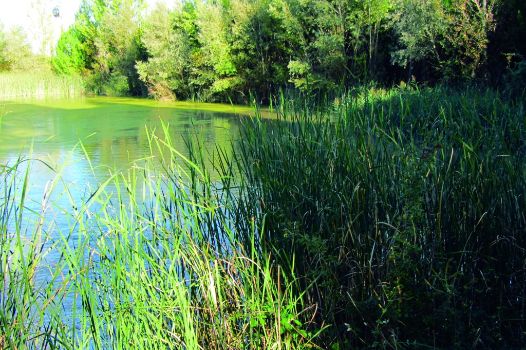Net of Natural
Trails

Stage 14: Tudela de Duero - Puente Duero
Description
Pinewoods in the heart of Valladolid
Stone pine forests play a starring role in this Stage, which runs mostly under large, balloon-shaped canopies that provide shade. The landscape, dotted with sizable towns, is still noteworthy, although it has been more affected by human activity than in previous Stages. The final stretch traverses through Pinar de Antequera, a forest very popular with the inhabitants of Valladolid, who regards this place as an excellent recreational space.
The Stages begins at the urban riverside park of Tudela de Duero, near the pier. The route runs through the park to the bridge on the river, which it crosses. The beautiful Shrine of Santo Cristo, built in the sixteenth century with an ashlar façade, appears in the distance.

After crossing the bridge, the route turns right and continues along the first street that emerges on the right (Herrera Street) to the municipal sports centre, and from there to Santinos pine forest. This pine forest is populated with large stone pine trees (Pinus pinea), typical of the sandbanks in the province of Valladolid.
At the recreational area, the route reaches a crossroad. It takes the road on the far right that leads through a pine forest to the Aula de la Naturaleza de Santinos, and from there to the River Douro. The path runs under a stone pine forest.
The Trail occasionally passes next to the River Douro, which flows wedged in between slopes carved by the water, and dotted with typical riparian trees that do not qualify as a riparian forest. The sandy slopes are riddled with holes where European Bee-eaters (Merops apiaster) nest. This small bird is unmistakable with its bright blue breast, greenish belly, cinnamon head, yellow neck and black stripe through the eye.

Further on, the path merges onto a larger road, Camino Herrera, where the route turns right. Shortly after, it crosses an abandoned railroad, leaving to the right a beautiful iron bridge on the River Douro.
The route passes through an aggregate mining site with a small pond, which is almost entirely covered by bulrushes. The site plays host to small mammals, including field mice (Apodemus sylvaticus) that come to drink at dusk, whilst Tawny Owls (Strix aluco) and Eurasian Eagle-owls (Bubo bubo) lurk for prey.
Further on, the road is paved, and usually flanked by lush pine trees, until Herrera de Duero. The route continues west along the main street that traverses the town following the signs. It takes the underpass that crosses the CL-601 and continues along the track to Puenteduero, where pine trees and irrigated farmlands alternate.
The pine forest has abundant underbrush, primarily holm oaks (Quercus ilex), which forms a dense forest within that is an ideal habitat for large mammals, such as wild boar (Sus scrofa), with plenty of food and shelter. One can occasionally catch a glimpse of the River Douro, whose riparian forest is now denser.

Close attention should be paid to the signs, as there are many paths along this route. Past a small gate, the path forks again. The route takes the left path leading out of the pine forest, and continues through an area in which farmlands and small pine stands alternate.
After crossing a road via an underpass, the route ventures through a semi-developed area with many structures and industrial buildings. Past several junctions and changes in direction, the route takes the road leading to an aggregate mining site near Pinar de Antequera.
Past the gravel pits, the route ventures into Pinar de Antequera, a stone pine forest heavily used for recreation and social activities by the inhabitants of Valladolid. The forest is populated with a variety of wildlife, in particular, squirrels (Sciurus vulgaris) and Azure-winged Magpies (Cyanopica cyanus), although Chickadees (Parus major), Blue Tits (Parus caeruleus) and Chaffinches (Fringilla coelebs) are also regular patrons.
The route turns left at the firewall, heading towards the nearby River Douro with its river beach, Playa de Puente Duero. One can rest at the recreational area nearby before taking the Camino de Pesquerón that leads to Puente Duero, the endpoint of this Stage.
Profile

Highlights
Further information
Pine nuts
Stone pines, which bear pine nuts, are one of the most desirable forest species for commercial uses. The Meseta Norte has been one of the richest in tradition in the world in the commercial use of stone pines from its pinewoods, documented since the Middle Ages.
Recent decades have seen growing interest in pine nuts as part of the Mediterranean diet, famous for its health benefits. Indeed, it has become the main resource of the vast majority of stone pine forests in the provinces of Valladolid, Segovia and Avila. The bulk of the Spanish production is processed at Pedrajas de San Esteban (Valladolid).
Pinar de Antequera
Pinar de Antequera is considered Valladolid's main green lung, and one of its major outdoor recreational and leisure areas. It has large spaces for hiking, trekking and cycling. The dominant vegetation is stone pine, with its unmistakable rounded crown, maritime pine, and an occasional holm oak. There is also a wide diversity of wildlife.





